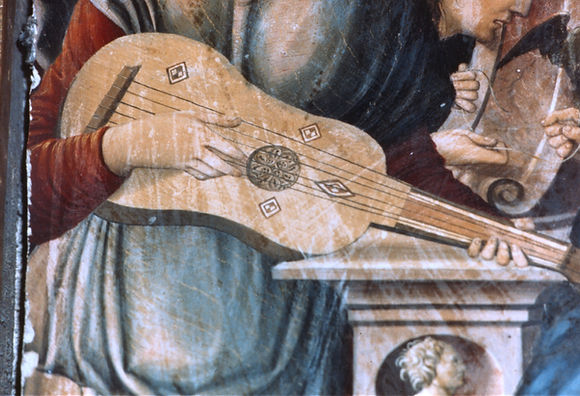
Vihuela Images | Imágenes de vihuelas
This page gives a selection of the hundreds of artworks that depict vihuelas and guitars from the 15th, 16th, and 17th centuries. It complements the images found on other websites. Many of the items here are linked to the Vihuela21 Database.
Esta página presenta una selección de los centenares de obras de arte que incluyen representaciones de vihuelas y guitarras de los siglos XV, XVI y XVII. Complementa las imágenes incluidas en otras páginas del internet. Muchas de las imágenes aquí tienen enlaces a la base de datos Vihuela21.

Vihuelas in the vihuela books | Vihuelas en los libros de vihuela
There are not many depictions of vihuelas in the printed vihuela books, only four. Luis Milán, El Maestro (1536) includes two. The first is the well-known picture of Orpheus playing the vihuela, taming wild animals and beasts in the fields of Arcadia. The second image shows a beautifully proportioned vihuela showing beginners the notes to which the vihuela's strings are tuned. (instruments 16-215 and 16-216 in Vihuela21. They can be seen in large size in the facsimile copy in Madrid, Biblioteca Nacional http://bdh-rd.bne.es/viewer.vm?id=0000022795
The frontispiece of Luis de Narváez. Los seys libros del Delphin (1538) is another symbolic repesentation showing the mythological figure of Arion being saved by a Dolphin after a shipwreck. (Vihuela21 image 16-201), and available online at http://bdh-rd.bne.es/viewer.vm?id=0000134585&page=1
At the very end of Alonso Mudarra. Tres Libros de Musica (1546) (online facsimile: http://bdh-rd.bne.es/viewer.vm?id=0000108275&page=1) there is another vihuela, less elaborately drawn, showing an Old Testament scene featuring the prophet Elisha and Psaltes from the second book of Kings (see 16-204)
In other Spanish music books
In other Spanish music and music theory books of the same period, there are some more illustrations. One of these comes in Juan Bermudo's book Declaracíon de instrumentos musicales (1555) in a chapter dedicated to the seven-course vihuela which Bermudo uses to show the position of notes on a seven-course instrument with an innovative new tuning (16-209). The other is a small decorative depiction of a vihuela-playing courtier that appears a dozen times in Milán' book of parlour games, Libro de motes (1535), (16-241)
7-course vihuela (Bermudo, Declaración, 1555)
Maestro de Castelsardo
In late fifteenth-century Sardinia, the Maestro de Castelsardo, a town on the northern coast of the island left us three depictions of vihuelas, all quite similar. If not copied from the same model, they show a distinct style of construction, possibly of monoxylic vihuelas carved from a single pieces of wood. One of these paintings is in Castelsardo, a second one is in the National Art museum in Cagliari on the southern coast while the third remains in the main church of the inland town of Tuili.
Surviving vihuelas
Spanish Paintings
Italian paintings
More to follow





















Courtier vihuelist from
Luis Milán, Libro de motes, 1535
Angel playing vihuela, from Retablo della Porziuncola, Castelsardo, after 1492.
Angel playing vihuela, from Retablo de Castelsardo, Cattedrale di Sant'Antonio abate, before 1492.
Angel playing vihuela, from Retablo de Tuili, 1489-1500.
Vihuela by Guadalupe, early 16th century. Musée Jacquemart-André, Paris. 16-124]
Anonymous Vihuela c. 1600, Convento de la Encarnación, Avila [16-315]
Anonymous Vihuela, c.1600, Iglesia de Nuestra Señora de Loreto, Quito, Ecuador, owned by Santa Mariana de Jesús [17-103]
Vihuela (or guitar) by Belchior Dias, Lisbon 1571, collection of the Royal College of Music, London [16-306]
Anonymous Vihuela, late 16th-century. Paris, Musée de la Musique [16-304]
